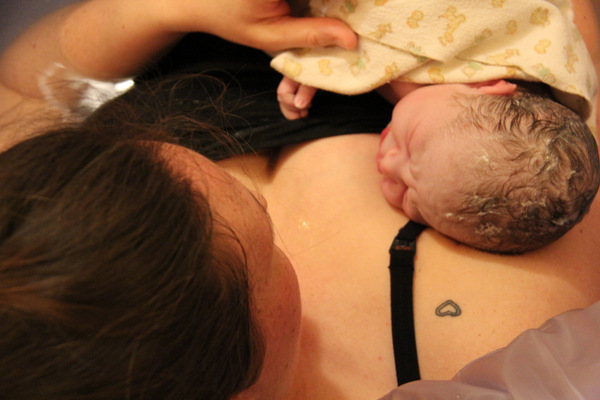
The very first moments after birth, when the baby is still attached to the mom by the umbilical cord, are a part of the birth process and important for both the mom and baby. In modern medicine, as soon as the baby is born and transitioning to breathing, mom and baby are treated as separate entities, the cord being cut quickly and often the baby is whisked away to be wiped off and dried, a hat put on, and vitals taken. All this happens while mom delivers the placenta, often with medical intervention through Pitocin (synthetic oxytocin) and sometimes cord traction.
After the exhaustion of pushing, mom often doesn’t have the energy to protest if the baby is swept away, and without understanding the crucial role that the baby pays in the 3rd stage of birth and the mom plays in regulating the baby’s heart rate, temperature, and breathing as it starts to breathe, she may not realize that it’s even a problem.
Skin-to-skin contact for both baby and mom after birth is natural and healthy. Placing the baby directly on mom, without wrapping him in a blanket or putting a hat on him first, allows the baby to adjust from life in the womb to life outside with the help of mom’s natural body heat, heartbeat, and breath rate. Baby is comforted by her familiar smell and voice.
Oxytocin, the love hormone, flows freely when mom holds her newborn and smells his sweet baby head, this helps the body to release the placenta and then create the needed contractions to expel it and clamp down on the freshly severed blood vessels. (source)
Delaying cord clamping (covered in chapter 25 of The Empowered Mother) also helps the placenta to be delivered easily, and the baby to get more oxygenated blood, decreases his later risk of anemia, and allows him to get more stem cells (source) as he transitions to breathing on his own. Most umbilical cords are long enough for baby to easily reach his mother’s chest for his first breastfeed.
Questions to discuss Prior to Birth:
- How would the 3rd stage look for me in different birthing positions (kneeling, squatting, all fours, laying back in bed, etc)?
- Does my care provider normally do cord traction, fundal massage, or cord clamping before the placenta is delivered?
- Is it important to me to know how much the baby weighs immediately?
- Is my care provider comfortable performing the newborn exam while the baby lays on my chest?
Original article and pictures take healthhomeandhappiness.com site
Комментариев нет:
Отправить комментарий